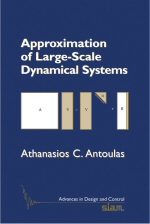 |
Approximation of Large-Scale Dynamical Systems
Athanasios. C. Antoulas
Advances in Design and Control,
SIAM (2005), 518 pp., Price: US $125.00 (hardcover) and US $87.50 (SIAM member price)
ISBN 978-0-898715-29-3 (hardcover). |
| Reviewer: Charles H. Morgan, Jr., Department of Mathematics, Lock Haven University of Pennsylvania, Lock Haven, Pennsylvania, U.S.A. |
Dynamical systems are the principal tool used in modeling a
number of physical phenomena such as weather or behavior of large-scale
integrated circuits. During the design phase of a modern computer processor,
designers must consider as many as 1,000,000 variables to model potential
interference and undesirable electromagnetic effects among the different
circuits within the chip. The overly large number of variables (i.e., the
complexity) of the model makes the problem computationally unwieldy;
therefore, a simplification of the model is necessary. Reducing the
complexity of the model means far less computation time and greatly reduced data
storage.
Reduction of the complexity of the model should be done so
that
-
approximation error is small and measurable,
-
essential properties (e.g., stability) of the original
system are preserved, and
-
the algorithm for reducing the model is computationally
stable and efficient.
Singular-value decomposition (SVD) methods are fairly complex
computationally and so are generally applicable to models with fairly small
complexity (See [1] for a nice overview.); however, SVD methods provide an
explicit value for the approximation error. Krylov-based reduction methods
require only matrix multiplication and so they are perfectly suitable for models
with very large complexity. The disadvantage with Krylov-based
approximations is that they lack an error bound, and stability of the original
model is not always preserved by the approximating system.
The purpose of Approximation of Large-Scale Dynamical
Systems is to present a combination of the SVD- and Krylov-based reduction
methods. The combined SVD-Krylov methods possess the best qualities of
both approximation methods: applicability to systems with high complexity
and the existence of an error bound. Because physical systems are locally
linear and because the theory of linear systems is rich and well-developed,
Antoulas concentrates appropriately on linear models.
The text begins with motivating examples before it presents
the essential tools from matrix theory and linear dynamical systems along with
the Sylvester and Lyapunov equations, which are necessary in the Hankel-norm
approximation methods. In this exhaustive, but wonderfully readable,
presentation (about 200 pages), the author gives extensive references and
citations essential to those new to the field and essential for a preservation
of the development of the field.
The remainder of the text addresses balanced truncation
methods and methods for balancing (e.g., Lyapunov, stochastic, bounded real, and
positive real balancing); Hankel-norm approximation, various methods for
constructing approximating models, and error bounds; various Krylov-based
methods for constructing approximating models; and finally, the purpose of
the text, SVD-Krylov methods. The final chapter of the book is a
presentation of case studies of the SVD-Krylov approximation techniques.
Approximation of Large-Scale Dynamical Systems is a
book which should be on the shelf of every applied mathematician, engineer, as
well as every graduate student in mathematics and engineering. To increase
its indispensability to practicing researchers and Ph.D. students, the book
contains a fourteenth chapter with a number of open problems involving nonlinear
systems, micro-electro-mechanical systems (MEMS), and other topics. To
make the book essential to faculty teaching graduate courses, the fifteenth
chapter contains a large number of exercises of varying degrees of difficulty.
Finally, one cannot omit from any review of this book a
discussion of its excellent readability. The quality of Antoulas's writing
is comparable to that found in Fritz John's classic text Partial Differential
Equations, one of the finest mathematics texts written and a particular
favorite of this reviewer.
Table of Contents
I. Introduction
-
Introduction
-
Motivating examples
II. Preliminaries
-
Tools from matrix theory
-
Linear dynamical systems: Part 1
-
Linear dynamical systems: Part 2
-
Sylvester and Lyapunov equations
III. SVD-based approximation methods
-
Balancing and balanced approximations
-
Hankel-norm approximations
-
Special topics in SVD-based approximation
IV. Krylov-based approximation methods
-
Eigenvalue computations
-
Model reduction using Krylov methods
V. SVD-Krylov methods and case studies
-
SVD-Krylov methods
-
Case studies
-
Epilogue
-
Problems
References
[1] C. Beattie and S. Gugercin, Approximation and
control of large-scale dynamical systems. Found at http://www.modelreduction.math.vt.edu.
|